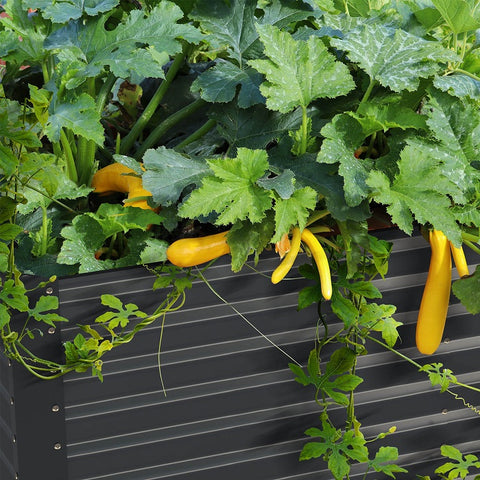In a way, a raised bed is like a large container. If you've depleted your soil of nutrients during one or more gardening seasons, you need to rebuild it. Of course, it's good to add organic fertilizers in the spring. However, they are not the complete answer to improving soil quality. Because by maintaining your soil properly, you won't need to replace it every few years. In fact, unless your plants are bringing in a soil-borne disease, you don't need to change your grow bed soil at all - just keep it on! What can you do to maintain healthy soil in raised beds? In this article, Savana will give you some tips.

1. Add Compost to Your Raised Bed
Compost is just not good for spring bed prep! In fall, add compost to your raised beds. On raised beds, composting is a great way to end the gardening season. Since this compost will sit in the bed all winter, it doesn't have to be fully decomposed. The composting process can actually take place on the raised bed.
Plus, it's a great way to clean up yard messes. Spread a few inches of compost over the bed, then cover with mulch. The mulch will protect the soil from harsh winter weather, keeping nutrients in the raised bed.
2. Use Soil Amendments in Raised Beds
Soil amendments are mixed with soil to improve its quality. Specifically, what a soil amendment does to your soil depends on the type of soil amendment you use.
You may want to consider using soil amendments to increase the nutrients in the soil or to change the physical structure of the soil, commonly known as the tillage layer. Simply put, this is basically the texture of the soil.
As an example, let's say, the soil in your raised beds is drying out too quickly. Or, maybe you didn't use the right soil mix to begin with. It's possible that you have too much sand in your soil, allowing water to drain quickly through the soil before the plants have a chance to absorb it.
You can correct the soil by adding a soil amendment rich in organic matter, such as compost. Organic matter will hold moisture in the soil. On the other hand, if the soil is retaining too much water, you can mix the greens with the soil, which will help it drain more efficiently.
Here is a list of some organic soil amendments that you might want to check out to improve the soil quality of your raised beds: vermiculite, vermicompost, compost, coir, greenery, grass clippings, cornmeal, alfalfa meal, lava sand, straw and kelp powder.

3. Plant a Cover Crop
When considering supplemental nutrition in raised beds, don't forget about cover crops. Cover crops aren't just for large-scale farmers looking for weed suppression. They will also provide raised beds for backyard gardeners.
Cover crops aerate the soil, especially if you're planting a cover crop with deep roots, such as alfalfa. The root system will pull nutrients from deep in the soil to the surface, which will make nutrients readily available when planting. Several weeks before planting, until the cover crop is in the soil. This increases organic matter, builds healthier soil, and increases nutrients.
If you want to add nitrogen to your soil, consider growing beans as a cover crop. Examples of legume cover crops are alfalfa, fava beans, and crimson clover. At the end of the growing season, after closing the beds, try planting a winter cover crop to protect and aerate the bed soil and add nutrients. Below is more information on cover crops, including a cover crop chart.
4. Try Lasagna Gardening
Lasagna gardening, sometimes called no-till gardening or sheet composting, is another great trick for improving soil conditions and an excellent way to create raised beds. So whether you want to start from scratch, or work on an existing raised bed garden, you can improve soil conditions right from the start. As your soil becomes depleted in your raised beds over time, you'll keep adding layers just as you would in a lasagna garden, completely renovating your soil from top to bottom with sheet compost.
Here's another great resource on lasagna gardening, including pictures of building a raised bed with lasagna gardening methods. Keep in mind that if you renovate your raised bed soil this way, you'll need at least six months for the layers to break down into plants.
This works great if you're rotating beds, or only planting for one garden season. If you want to plant right away, just spread two or three inches of compost or soil as a top layer and plant directly into the bed. Then you can start right away!

5. Prepare Raised Beds for the Winter
Don't forget that the end of garden season is a great time to do just a few simple steps of soil maintenance. It's a bit like closing stores for the winter. That is, if you're not in an area of the country where it can be grown year-round.
Here are two great tips for getting your beds ready for winter: Leave the roots in. Don't pull out the plants! Simply cut the plant at the surface of the soil. The roots will break down and aerate the soil. Spread a few inches of compost over the bed and cover with mulch. Mulch protects the soil during the winter, while compost adds nutrients during the winter. (Alternatively, you can skip the compost and mulch and grow cover crops.)
If you're considering hauling dirt from your raised bed and replacing it with brand new soil, try these 5 tips to improve the quality of your raised bed soil and save yourself the hassle. This is much easier than getting rid of what you have and starting from scratch. It is also very effective in improving soil quality.









